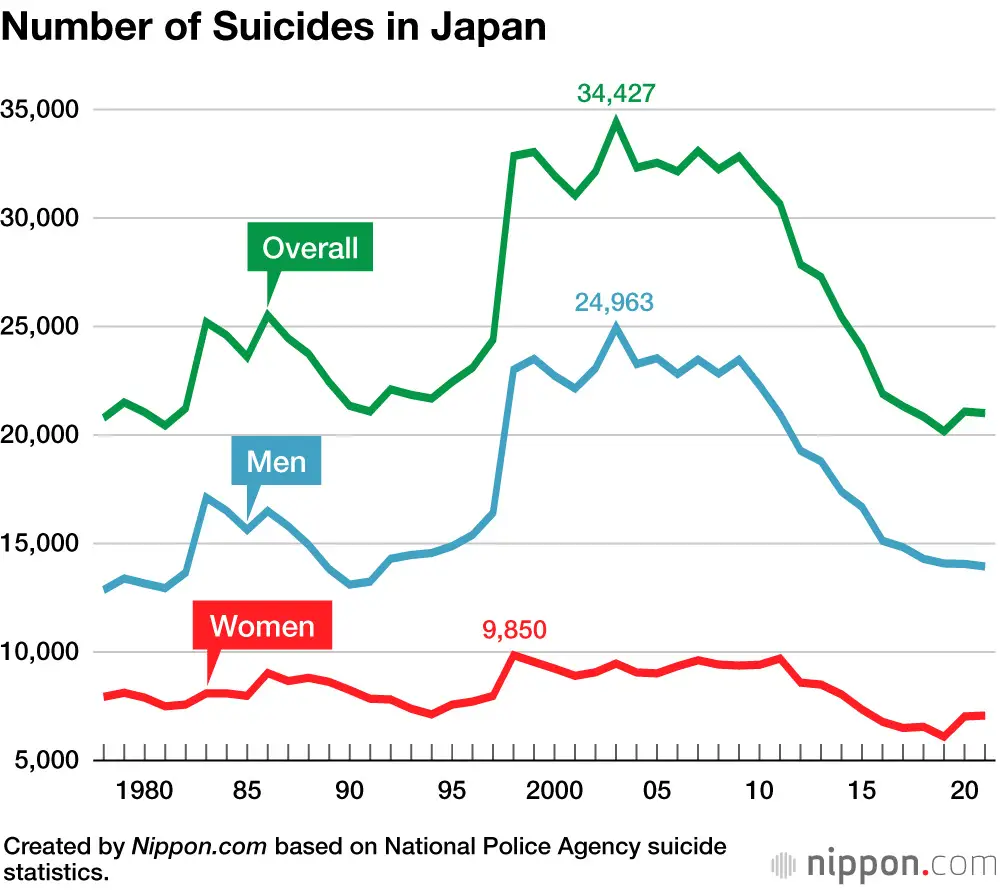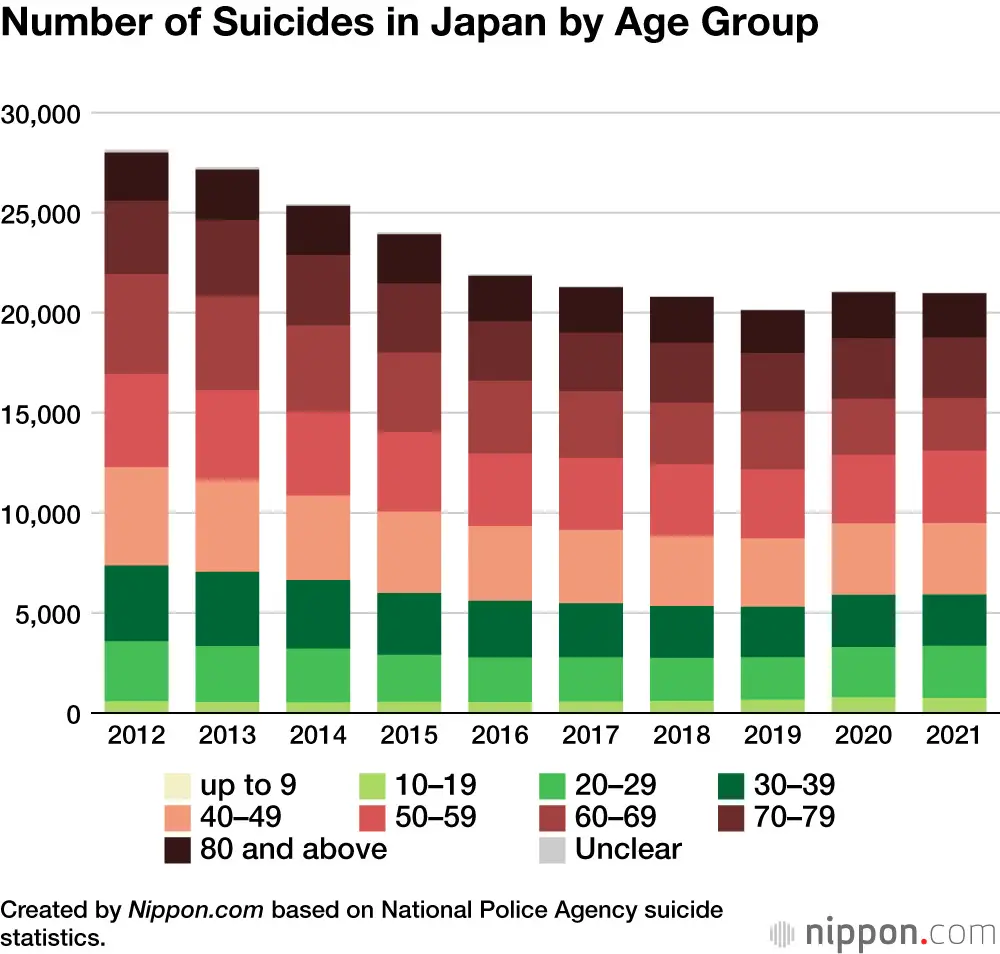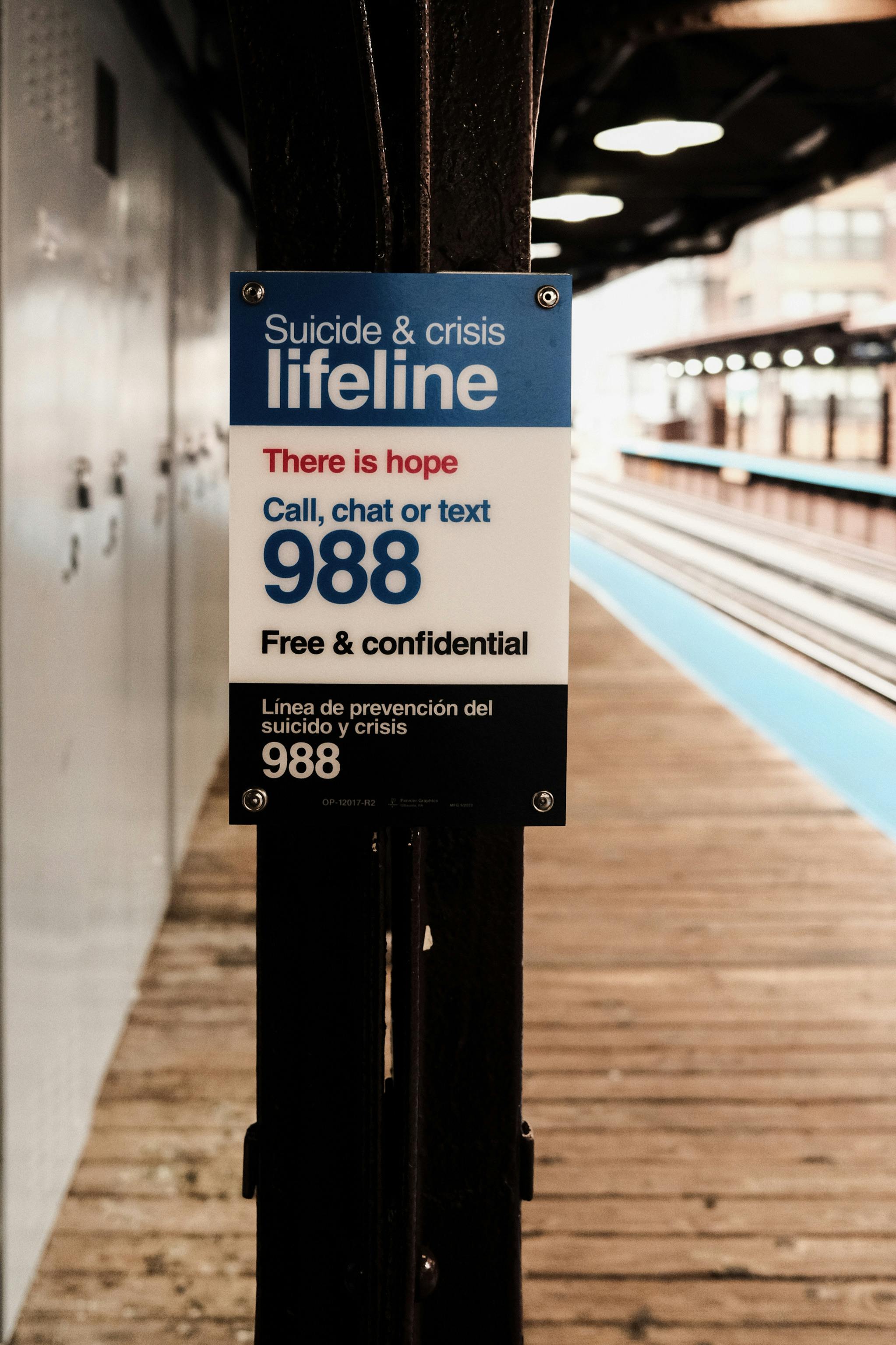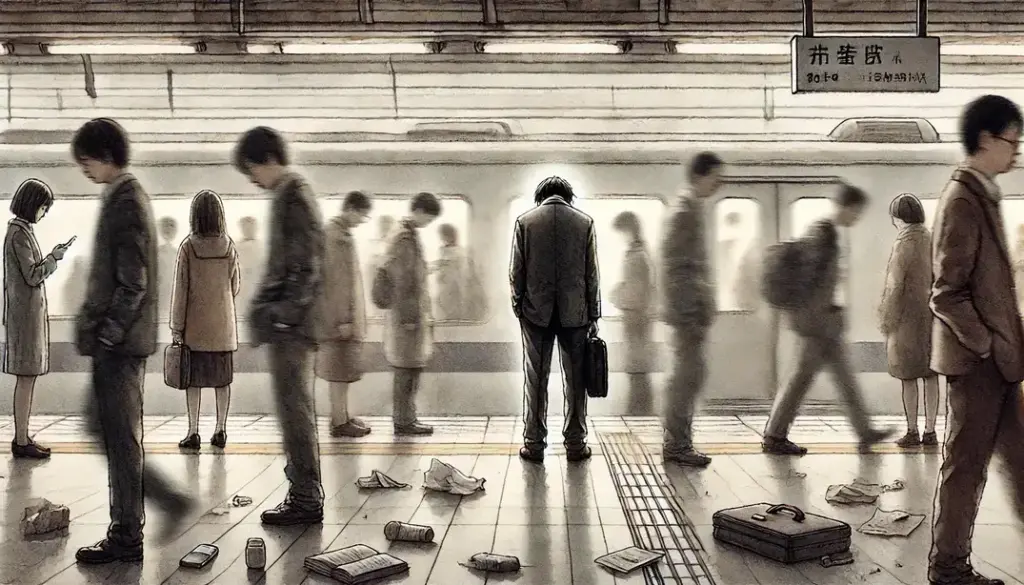Suicide Rates in Japan have been a topic of global attention for years, reflecting deeply rooted cultural, societal, and economic impacts. While a steady decline was seen from 2009 to 2019, recent shifts indicate a rise in cases among specific groups, including young people and women. Factors like social isolation, academic pressures, and the ongoing effects of the COVID-19 pandemic have added to this complex issue. Understanding these trends sheds light on why suicide remains a critical concern despite the nation’s extensive prevention efforts.
Suicide Rates in Japan: Historical Trends
For decades, the suicide rate in Japan has been a subject of significant concern, reflecting the interplay of cultural expectations, economic transitions, and societal issues. The trends provide a window into moments of national struggle and eventual recovery.

Peak Periods of Suicide Rates
Japan faced its most alarming rates of suicide during the late 1990s and early 2000s, particularly in 1998, when the rate jumped by an astounding 34.7% from the previous year. This sharp increase was attributed to the Asian Financial Crisis, which left many unemployed and financially struggling. The economic downturn magnified feelings of shame and hopelessness, both of which are culturally tied to the concept of honour in Japan and historically linked to suicide. Learn more about the crisis’ role in suicide trends here.
The early 2000s maintained high rates, peaking in 2003 with around 34 people per 100,000 taking their lives. Male suicides during this period were disproportionately higher due to traditional roles as primary breadwinners. Additionally, the concept of karoshi—death by overwork—became increasingly prominent. Overwork and professional stress, though never new, escalated during this time. A study citing this phenomenon highlights how heavy workloads often contribute to mental health deterioration and fatal outcomes. Read more about overwork-related suicides here.
Other factors during this period included the rise of cyberbullying and online suicide pacts facilitated by Japan’s early adoption of the internet. These social dynamics created unique challenges that lingered through the 2000s.

Recent Declines and Contributing Factors
After peaking in the early 2000s, Japan saw a steady decline in suicide rates, with marked improvements in the past two decades. By 2019, the suicide rate had decreased by over 40% compared to the early 2000s. Many credit this trend to targeted government policies and shifting societal attitudes. More on the decline here.
Key contributing factors include:
- Government Initiatives: In 2006, Japan introduced its first Basic Act for Suicide Prevention, laying a foundation for coordinated nationwide efforts. Increased funding supported mental health care programs and public awareness campaigns.
- Workplace Reforms: Recognizing the dangers of overwork, measures like improved labor laws and caps on overtime hours helped reduce workplace stress. Companies were encouraged to provide mental health resources for employees.
- School and Youth Outreach Programs: Recognizing that younger populations could help break longstanding stigmas, schools incorporated mental health education and anti-bullying campaigns into their curriculums.
- Enhanced Mental Health Access: Investments in community-based mental health clinics and crisis hotlines played a crucial role. These services became lifelines, particularly during spikes in stress, such as the COVID-19 pandemic. Explore detailed data on the pandemic’s impact on suicide rates here.
The decline in suicide rates in Japan has been celebrated as a success, but experts caution against complacency. Economic anxiety, increasing work pressures, and mental health stigma still linger. While progress is undeniable, continued vigilance is essential to sustain improvements and support vulnerable groups.
Demographics of Suicide in Japan
Understanding the demographics of suicide in Japan reveals critical insights into how societal factors, age groups, and cultural norms intersect with mental health. Exploring the differences by gender, age, and life stage helps paint a clearer picture of Japanese society’s challenges.

Gender Disparities in Suicide Rates
In Japan, suicide rates are consistently higher among men than women. In fact, men account for approximately 70% of suicides nationwide. This disparity can be attributed to traditional gender roles deeply embedded in Japanese culture. Men are often expected to be the primary earners and the cornerstone of financial stability for their families. When economic crises or job losses occur, the shame and stress of failing to meet these societal expectations can weigh heavily.
Additionally, the phenomenon of karoshi—death by overwork—magnifies the pressures on working-age men. Long working hours, combined with limited mental health support, leave little room for coping mechanisms. Stress compounds over time, leading many to feelings of hopelessness. Research also highlights that men are less likely than women to seek help for mental health, further perpetuating the problem. Explore gender-specific data on suicide rates here.
Suicide Among Schoolchildren and Young Adults
Alarmingly, Japanese schoolchildren and young adults face increasingly high suicide rates. Suicide is the leading cause of death for individuals aged 15 to 24 in Japan, a tragic statistic that reflects immense academic and societal pressures. A competitive education system and the expectation to gain entry into prestigious schools and universities are often overwhelming. Many youths feel trapped in an endless cycle of stress, with limited outlets for relief or support.
Bullying, both online and in person, has emerged as another critical factor. The rise of cyberbullying exacerbates a problem that already plagues many young people, leading some to experience severe anxiety and depression. For others, the pandemic years amplified isolation and loneliness. Learn more about the challenges faced by Japanese youth.
Interestingly, many suicides in this demographic occur during particular seasons, such as the start of a new school year in April. This suggests that transitions and societal pressures create vulnerable periods for young people.
Middle-Aged and Elderly Populations
Middle-aged individuals and seniors in Japan also experience significant rates of suicide, albeit for different reasons. Men aged 50 to 59 often face challenges with job security, retirement, and family financial stability. The stigma surrounding job loss or underemployment adds another layer of psychological burden. Get detailed insights on suicide rates by age group.
For elderly populations, loneliness and social isolation serve as key drivers. Japan’s ageing society comes with its own issues, including a lack of familial support as younger relatives move to cities for work. Seniors may feel abandoned or unable to cope with declining health and independence. Interestingly, “double suicides,” where elderly couples choose to end their lives together, underscore the cultural nuances tied to ageing and companionship in Japan. Explore a deeper look into elderly suicides here.
By examining these demographic divides, we better understand the distinct struggles each group faces and how intertwined societal expectations are with mental health outcomes.
Major Causes of Suicide in Japan
Multiple facets, including economic pressure, societal expectations, and cultural norms shape Japan’s suicide rate. These factors intersect in complicated ways, contributing to a persistently high rate of self-inflicted deaths that distinguishes Japan from other nations. Let’s break down the major causes.

Economic Stress and Financial Hardship
Japan’s heavy work culture and societal emphasis on financial stability play a significant role in driving suicide rates. For many, work is more than just a means of livelihood—it’s a core part of identity. Losing a job or facing financial strain can be devastating, not just materially but emotionally. Concepts like karoshi (death from overwork) highlight how extreme Japan’s labour expectations can be.
Periods of economic downturns, such as the Asian Financial Crisis, have historically led to spikes in suicide. Many workers, especially men, feel immense shame in not fulfilling traditional roles as family providers. This cultural burden magnifies the impact of unemployment or underemployment. Recent research shows financial uncertainty disproportionately affects specific groups, such as middle-aged men. Learn more about how economic factors affect suicide rates in Japan here.
Challenges remain while the government has initiated workplace reforms to curb overwork and encourage mental health support. Financial stress often makes people feel trapped, with no visible way out. Initiatives must address this key driver to enact real, lasting change.
Mental and Physical Health Issues
Mental health challenges are not just an underlying factor; they are at the heart of many suicides in Japan. Depression, anxiety, and chronic stress are often left untreated due to the stigma associated with seeking help. In Japan, admitting to psychological problems can feel like a loss of dignity or an admission of weakness.
Overlaps with physical health problems further complicate this stigma. For instance, elderly populations battling long-term illnesses or disabilities are especially vulnerable. Poor health combined with social isolation makes seniors more susceptible to suicidal thoughts. The interconnection between mental and physical well-being creates a vicious cycle that can be hard to escape. Explore statistics on suicide and health trends in Japan here.
Unfortunately, mental health treatment is often underutilized or dismissed entirely because broader systems have traditionally undervalued emotional well-being. Public awareness campaigns and improved access to therapy are steps in the right direction, but overcoming longstanding stigmas will require even deeper cultural shifts.
Cultural Factors and Societal Norms
Japan’s cultural values around honor, shame, and responsibility can make suicide seem like a way out for those under immense pressure. Historically, acts like seppuku during the samurai era established a precedent associating suicide with redemption or reclaiming lost honor. Today, echoes of this mindset persist, especially among individuals who feel they’ve let down their families or communities.
Social isolation is also a significant factor. Japan’s aging population, coupled with declining birth rates, leaves many elderly individuals without close family ties. Similarly, the intense pressure on students and workers isolates many from meaningful social support. In a collectivist society like Japan, falling short of group expectations can lead to feelings of alienation and failure. Read more about how cultural influences shape Japan’s suicide rates.
Beyond internal pressures, cultural narratives around death can sometimes glorify or normalize suicide. Dramas and literature in Japan often romanticize self-sacrifice, reinforcing dangerous ideas for vulnerable individuals. Recognizing and combating these societal influences is crucial for reducing stigma and providing alternative narratives.
Impact of the COVID-19 Pandemic
The COVID-19 pandemic disrupted societies worldwide, and Japan was no exception. While the virus brought widespread health and economic challenges, its hidden effects, particularly on mental health, emerged as significant concerns. In Japan, the pandemic highlighted vulnerabilities in groups like women and children, contributing to an increase in already worrisome suicide rates. Let’s examine these impacts more closely.
Rising Rates Among Women and Children

Photo by ANTONI SHKRABA production
During the pandemic, suicide rates among women and children in Japan saw a troubling spike. Women, in particular, faced unique pressures. With school closures, job losses, and increased domestic responsibilities, many women found themselves overwhelmed. Those in precarious employment, such as part-time or contract workers, were especially vulnerable to financial stress. Studies have shown a significant increase in suicides among women during the pandemic’s early months (source).
For children, isolation due to school closures and reduced social interactions took a toll. The move to online learning cut many young people off from their peers, creating a sense of loneliness. Bullying, both online and within families, reportedly increased during this period, further exacerbating the problem. Reports indicate that distress caused by educational pressures, combined with limited access to counseling or support services, pushed some children into mental health crises (source).
Long-Term Psychological Effects
The consequences of the pandemic are not confined to its peak years. The mental health crisis triggered by COVID-19 could have enduring impacts on suicide rates in Japan. Many individuals who experienced job loss, social isolation, or the death of loved ones during the pandemic are still coping with anxiety and depression.
Among women, the pandemic amplified issues like domestic violence and diminished gender equality, both of which leave lasting emotional scars. Without timely intervention, these challenges may continue to drive mental health struggles. Similarly, children who faced heightened loneliness or witnessed family stress during the pandemic could carry those experiences into adulthood, shaping their mental well-being in profound ways.
Public health experts warn that the “aftershocks” of the pandemic may resurface during societal transitions, such as returning to in-person work or adjusting to new norms (source). This means that suicide prevention efforts must focus on both immediate and long-term support systems to mitigate these risks.
The COVID-19 pandemic has created an urgent need for better mental health care and social support, particularly for groups that have faced unique struggles. By understanding these impacts and addressing the root causes, Japan can pave the way for a resilient mental health framework that supports its most vulnerable citizens.
Government Measures and Prevention Programs
Japan has actively addressed its high suicide rate through comprehensive governmental policies and prevention programs. These initiatives aim to create a society where no one feels driven to take their life. Significant strides have been made over the years, showcasing how targeted measures can bring about meaningful change.
The Basic Act on Suicide Countermeasures
Enacted in 2006 and later revised in 2016, the Basic Act on Suicide Countermeasures serves as the cornerstone of Japan’s national strategy to combat suicide. This legislation emphasizes a multidisciplinary approach, addressing social, economic, and health-related factors that contribute to suicide. It established the General Principles of Suicide Prevention, focusing on:
- Improving access to mental health services
- Enhancing public awareness campaigns
- Supporting bereaved families of victims
The Act represents a shift in viewing suicide not merely as an individual’s issue but as a broader societal concern. Results have been promising: between 2009 and 2019, suicide rates in Japan saw a steady decline, with significant progress in reducing male suicides. However, the recent rise in cases among women and children shows there’s still more work to be done. Learn more about the Basic Act on Suicide Countermeasures here.

Photo by Airam Dato-on
Community Initiatives and Support Networks
Grassroots programs and local support networks are key contributors to Japan’s suicide prevention efforts. Municipal governments and non-profit organizations work collaboratively to reach vulnerable individuals in their communities.
Some innovative programs include:
- Mental health awareness campaigns: These focus on educating the public about stress management and reducing the stigma surrounding help-seeking behavior.
- Early detection systems: Local governments, like those in Akita Prefecture, incorporate mental health checks into broader health initiatives. Programs like Health Akita 21 have reported success in identifying high-risk individuals early.
- Safe spaces and crisis hotlines: Organizations offer confidential support lines and drop-in centers, creating lifelines for those in need.
Community-driven efforts build trust and foster a sense of belonging—elements often missing in the lives of those at risk. Explore Japan’s community-based suicide prevention programs here.
Targeted Help for High-Risk Groups
Recognizing that some demographics are more vulnerable to suicide, Japan has implemented programs that address the specific needs of women, children, and the elderly.
For Women:
Women have experienced increased suicide rates, particularly during times of national crises like the COVID-19 pandemic. To combat this, the government has created programs offering mental health resources for mothers, survivors of domestic abuse, and women with precarious employment. Access to counseling and financial support is crucial in helping them regain stability.
For Children:
Suicide is heartbreakingly the leading cause of death among Japanese youth. Efforts to address this include:
- Anti-bullying campaigns in schools
- Comprehensive mental health education
- Increased access to school counselors
Such interventions aim to relieve the pressures associated with academic competition and social isolation.
For the Elderly:
Japan’s aging society faces unique challenges, such as loneliness and a lack of familial support. Programs like visiting nurse services for seniors and community centers for the elderly help mitigate the isolation that many face. Some initiatives even encourage intergenerational interactions, fostering connections between youth and seniors.
Programs tailored to specific groups demonstrate how strategic focus can reduce vulnerability and save lives. Read more about targeted suicide prevention strategies for high-risk groups.
These government measures and community-led initiatives collectively form an essential framework for addressing Japan’s suicide crisis. However, the fight is ongoing, and further innovation is needed to adapt to emerging challenges.
Cultural Shifts and Societal Changes
In Japan, the way mental health and education intersect with societal expectations is changing fast. The country has a long history of addressing serious societal issues, and when it comes to mental well-being and awareness, significant progress is being made. Below are two key areas of focus that highlight how Japan is evolving to create a stronger, more supportive society.
Breaking the Stigma Around Mental Health

Photo by cottonbro studio
Mental health in Japan has long been a taboo subject, hidden behind cultural expectations of stoicism and self-reliance. Historically, seeking help for mental health struggles was viewed as a sign of weakness. This stigma led many to suffer in silence, exacerbating issues like depression and anxiety that often play a role in suicide.
However, times are beginning to change. Public figures are stepping up and speaking out about their mental health struggles. Celebrities, athletes, and even politicians are sharing their stories, making it easier for everyday people to do the same. The government and non-profit organizations have also launched campaigns aimed at normalizing open discussions about mental health. For example, the Basic Act on Suicide Countermeasures includes provisions to raise awareness and educate people about the importance of mental health care (source).
Other efforts include community-led initiatives like kokoro no care centers (mental health care centers), which provide counseling and group therapy. These centers make it easier for individuals to access professional help without fear of judgment. Additionally, workplaces and schools have begun incorporating mental health workshops to reduce stigma and offer employees and students safe spaces to talk. Learn about how mental-health-related stigma is being addressed in Japan.
Increased Awareness Through Education
Education systems and workplaces in Japan are also playing vital roles in raising awareness about mental health. Schools, in particular, have started integrating programs that teach students how to identify and cope with stress. This proactive approach is aimed at addressing issues like school bullying, academic pressure, and social isolation—factors that weigh heavily on young people and contribute to the nation’s suicide rate.
Some schools have introduced anti-bullying pledges, peer support groups, and mental health check-ins with school counselors. These programs encourage kids to recognize signs of stress in themselves and their classmates. By addressing these issues early, schools aim to prevent the spiral into more severe mental health challenges later in life.
Workplaces aren’t far behind. Many offices now offer stress management training and access to mental health support as part of employee welfare initiatives. This is particularly critical in Japan’s corporate culture, where long working hours and high expectations often contribute to burnout.
Overall, education and awareness efforts are becoming a foundational part of Japan’s strategy to combat societal issues linked to suicide. These programs not only target the current generation but also lay a groundwork for a societal shift toward acceptance and understanding. Read more about how Japan enhances awareness through education.
Conclusion
Japan’s suicide rate reflects a complex intersection of cultural expectations, economic pressures, and societal changes. While progress has been made in recent years, challenges persist, especially for women, children, and the elderly. The rise in school-age suicides and pandemic-related spikes among women highlight the need for nuanced, inclusive strategies.
Hope lies in collective efforts. Societal shifts, targeted government policies, and community-driven programs are laying the groundwork for change. Normalizing mental health discussions and providing accessible support systems can save lives.
Ending suicide in Japan requires ongoing awareness and action. Every step toward understanding and support brings us closer to a future with fewer untold stories.


